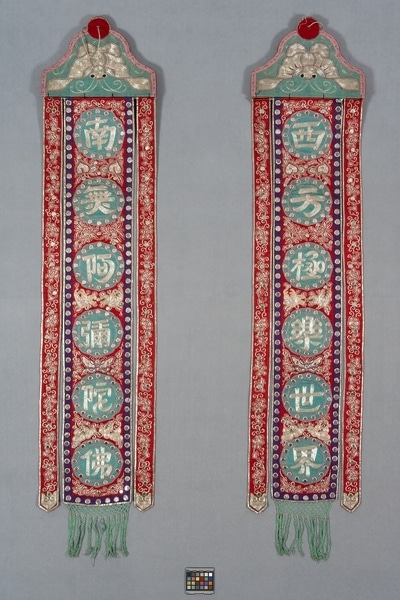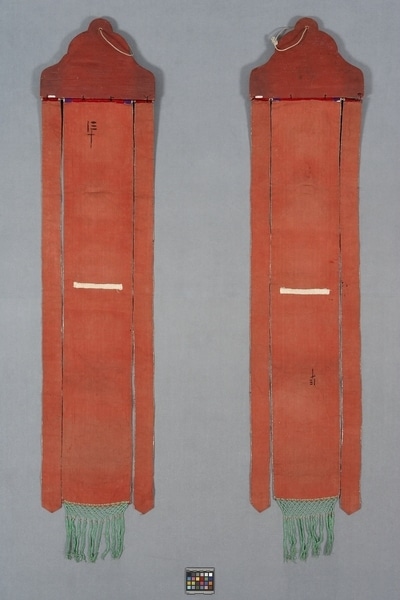Cantonese Opera Banner Item Number: N1.739 a-b from the MOA: University of British Columbia


Description
Pair of matching hanging panels (parts a and b); each consists of three pieces of embroidered cloth attached to a decorative wooden head piece. Head piece is straight across the bottom, scroll-shaped on top, made of wood painted rust red at back and sides, with silk glued and nailed to the front. Front of headpiece is covered with an embroidered silver butterfly motif on green ground with a large red circle; edge is outlined with pink ribbon. Suspended from head are three panels: a wide central one flanked by two narrow ones. Central panel: Chinese characters silver on green ground, appliqued (six circles). Butterfly, peach and gourd motifs, silver on red ground, blue edging; central panel finished at bottom with green knotted fringe. Side panels: peony motif, silver on red ground. Red cotton lining. Hole drilled in wood at top, with string loop for suspension.
History Of Use
These banners were carried or suspended on stage using the cord loop at the top and the cotton tape loop on the back to insert a pole. They were used in an opera concerning the goddess Guanyin (Cantonese: Gun Yam) transforming into 18 aspects
Costumes and stage accessories from the period before World War II can be dated in part by their ornamentation. Those decorated with silver-coated brass disks are likely to be the oldest, followed by those decorated with mirrors. Sequins came into use in the 1930s, although they had been used sparingly before, and heavily-sequined costumes came into use in the late 1930s, continuing into the 1950s.
The conditions of production of costumes pre World War II are not known with certainty. As most costumes have repeated motifs, some method must have been used to replicate them for embroidery and couching. This work was probably done on a putting-out basis under the auspices of the production company, by women. The final finishing may have been done by men in the company headquarters.
Specific Techniques
Wear on other costume elements shows that the fabric was woven with a silk weft and cotton warp, or vice versa.
Cultural Context
theatre
Narrative
A large group of Cantonese opera costumes, musical instruments, props, trunks, and stage fittings was left with the Jin Wah Sing Musical Association, apparently by some of the many itinerant troupes visiting Vancouver to perform in the Chinatown theatres in the pre World War II period. There is no certain knowledge of why these materials were not taken back to China by them. They were used by the Jin Wah Sing Musical Association in their performances until they became too dated. The association continued to preserve them carefully, storing them in their headquarters and in the basement of the Chinese Freemasons building until several groups of materials were sold and donated to the Museum of Anthropology.
Item History
- Made in Guangzhou, Guangdong, China ? during 1920
- Collected in Vancouver, British Columbia, Canada
- Owned by Jin Wah Sing Musical Association before August 28, 1973
- Received from Barrett Montford Endowment Fund (Funding source), Jin Wah Sing Musical Association (Seller), Leon & Thea Koerner Foundation (Funding source), Museum of Anthropology Donations Fund (Funding source), Mah Society of North America (Funding source), Canada-China Friendship Association (Funding source), Quon H. Wong Agencies (Funding source) and Edith Low-Beer (Funding source) on August 28, 1973
What
- Name
- Cantonese Opera Banner
- Identification Number
- N1.739 a-b
- Type of Item
- banner
- Material
- silk fibre, cotton fibre, dye, wood, brass metal, silver metal, gold metal, iron metal, paint and glass
- Manufacturing Technique
- cut, painted, spun, woven, dyed, sewn and knotted
- Part A
- height 167.0 cm, width 34.0 cm
- Part B
- height 162.0 cm, width 33.0 cm
Who
- Culture
- Chinese: Cantonese
- Previous Owner
- Jin Wah Sing Musical Association
- Received from
- Barrett Montford Endowment Fund (Funding source), Jin Wah Sing Musical Association (Seller), Leon & Thea Koerner Foundation (Funding source), Museum of Anthropology Donations Fund (Funding source), Mah Society of North America (Funding source), Canada-China Friendship Association (Funding source), Quon H. Wong Agencies (Funding source) and Edith Low-Beer (Funding source)
Where
- Holding Institution
- MOA: University of British Columbia
- Made in
- Guangzhou, Guangdong, China ?
- Collected in
- Vancouver, British Columbia, Canada
When
- Creation Date
- during 1920
- Ownership Date
- before August 28, 1973
- Acquisition Date
- on August 28, 1973
Other
- Item Classes
- textiles
- Condition
- fair
- Accession Number
- 0248/0124 a-b